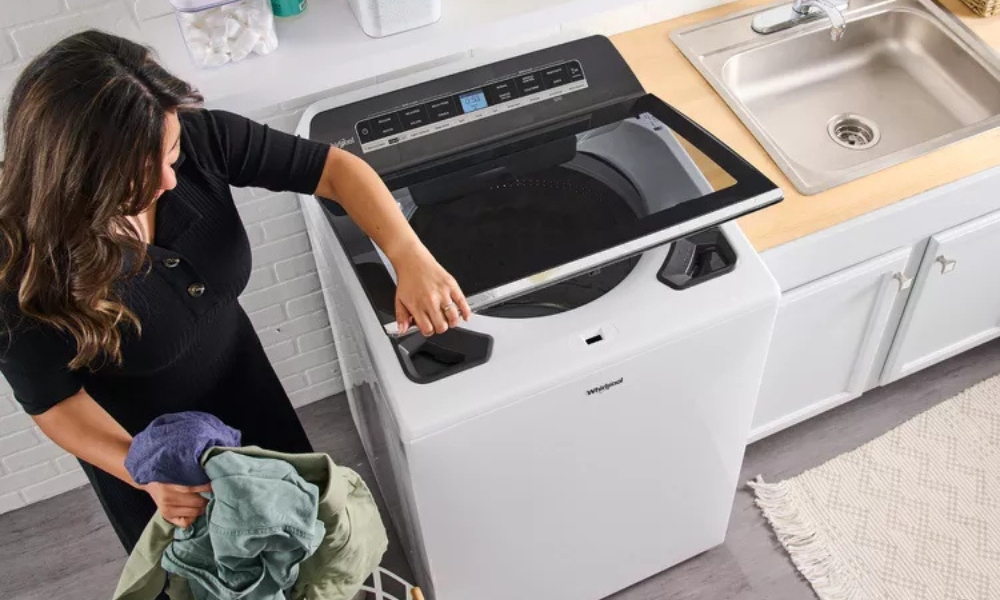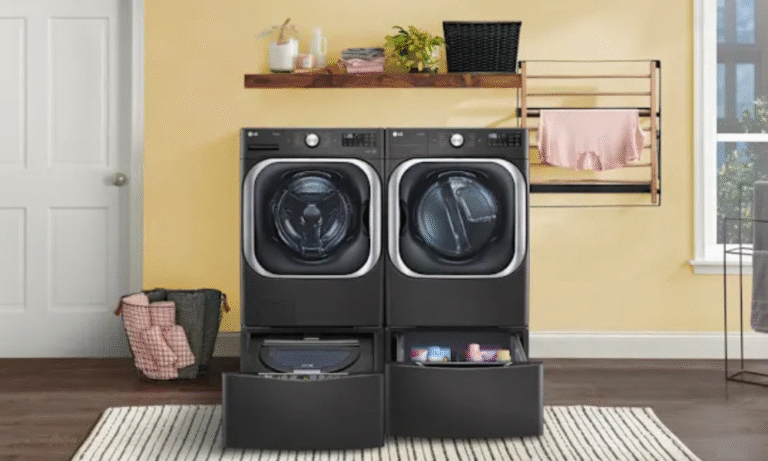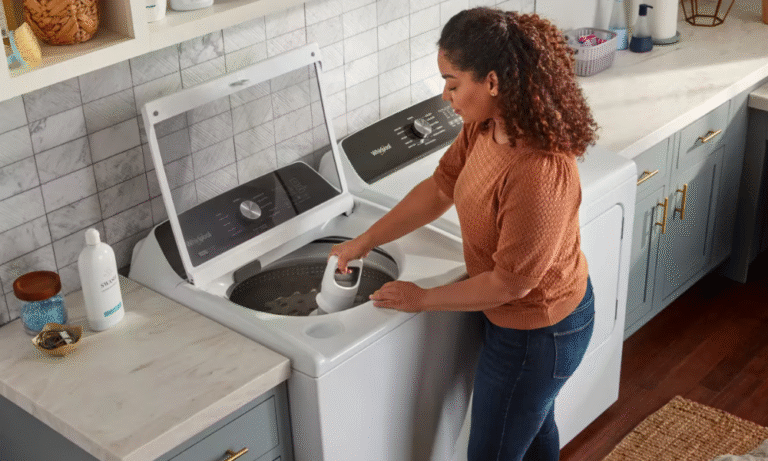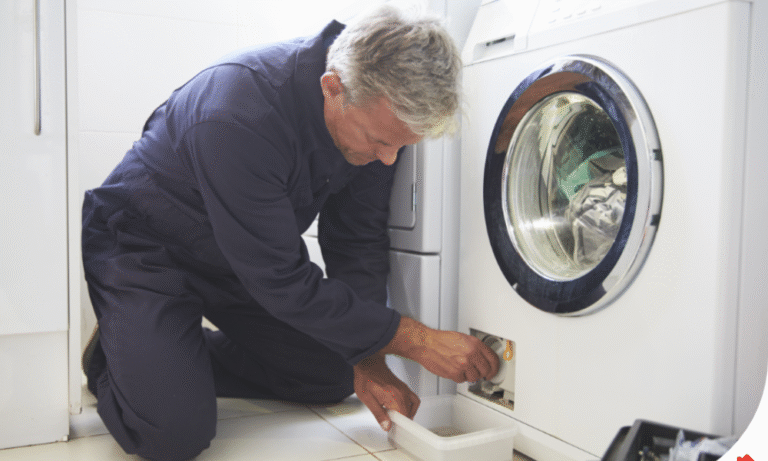Estimated reading time: 12 minutes
Last updated on August 21st, 2025 at 05:41 am
Modern washing machines have revolutionized the way we do laundry and have become a necessary part of our everyday life. Which type to choose—front-load or top-load—is one of the key considerations when selecting a washing machine. This front-load vs. top-load washing machine comparison is crucial because it enables customers to make an informed choice based on their requirements and preferences.
Washing machines that are front-load and top-load have different designs, features, and capabilities. The decision between the two is influenced by a number of variables, including available space, load capacity, energy efficiency, water consumption, usability, and cleaning efficacy. People may choose the choice that best fits their needs and way of life by being aware of the differences between front-load and top-load washing machines.
What Is a Front-load Washing Machine

Photo Credit: samsung
Customers frequently choose front-load washing machines because of their cutting-edge functionality and creative design. To better comprehend front-load washing machines, consider the following essential points:
Design
A horizontal drum that revolves on a horizontal axis is a feature of front-load washers. Compared to top-load washers, this design’s ability to tumble garments in and out of the water results in a more gentle washing process. The term “front-load” refers to the location of the entrance on the machine.
Load Capacity
Compared to top-load washers, front-load washers often offer a bigger load capacity. They are appropriate for homes with heavier washing loads since they can carry bulkier things like comforters and duvets.
Efficiency
The effectiveness of front-load washing machines is well recognized. When compared to top-load washers, they consume less detergent and water. Additionally, they frequently spin at greater speeds, which aids in removing more moisture from the garments and cuts down on drying time and energy use.
Cleaning Performance
Due to their capacity to agitate clothing more efficiently and their tumbling movement, front-load washers perform exceptionally well in terms of cleanliness. The horizontal drum makes sure that the clothing is properly washed and immersed.
Space Considerations
In order to conserve space in small laundry rooms, front-load washers can be stacked on top of a suitable dryer. For homes or flats with limited space for separate washing and dryer units, this function is very useful.
Price
In general, front-load washers cost more upfront than top-load washers. However, by using less water and energy, their efficiency and cutting-edge features can result in long-term cost benefits.
Maintenance
It’s vital to remember that front-load washers need routine maintenance to stop the formation of mold or mildew. To prevent moisture buildup, the drum should be left to air dry after each use and the door gasket and detergent dispenser should be regularly cleaned.
People may choose a washer that best meets their requirements and preferences by being knowledgeable about the characteristics and benefits of front-load washing machines.
Exploring Top-Load Washing Machines

Photo Credit: maytag
Many people choose top-load washing machines because they are convenient and straightforward. Let’s examine a few crucial features of top-load washers:
Design
Top-load washers have a vertical drum that fills with water from the top, unlike front-load washers. A door on the top of the machine is used to load and unload clothing.
Load Capacity
Top-load washers generally have slightly smaller load capacities compared to front-load washers. They are excellent for most homes since they can still store large laundry loads.
Usefulness
Top-load washers’ usability is one of their key benefits. Users don’t have to stoop as low to load and unload clothing because the drum is located at a higher height, which might be advantageous for people with back or mobility concerns.
Agitator vs. Impeller
Traditional top-load washers often feature an agitator, a central pole with fins that move the clothes around for cleaning. The impeller, a low-profile disc at the bottom of the drum that generates mild turbulence for efficient cleaning, is a feature that certain more recent models may contain. Impeller types often have a bigger drum to accommodate larger things.
Cost
Compared to front-load washers, top-load washers are often less expensive upfront. They are a desirable choice for folks on a limited budget because of their accessibility.
Speed
Top-load washers frequently have cycle durations that are less lengthy than those of front-load washers. When you need to rapidly wash a smaller load of clothing, this might be useful.
Maintenance
Compared to front-load washers, top-load washers are typically simpler to maintain. They require less regular cleaning and are less likely to develop mold or mildew. To ensure peak performance, it’s still crucial to routinely clean the filter, detergent dispenser, and drum.
Individuals may choose a top-load washing machine based on their own needs and preferences by being aware of its characteristics and advantages. Top-load washers are a practical laundry option for many families, whether it’s because of their simplicity of use, low cost, or quicker cycle times.
Factors to Consider When Choosing Between Front-Load and Top-Load Washing Machines

Photo Credit: brayandscarff
It might be important to decide between a front-loading and a top-loading model when purchasing a washing machine. It’s crucial to take into account a number of variables that may affect your experience doing laundry before making a decision. When picking between front-load and top-load washing machines, keep the following points in mind:
Space Availability
Evaluate the available space in your laundry area. Due to their bigger size and the requirement for the door to swing open, front-load washers often demand more room. Top-load washers, on the other hand, are often smaller and may work better in small laundry rooms.
Load Capacity
Consider your laundry needs and the typical size of your laundry loads. You can wash more clothing in one cycle with front-load washers since they generally have a bigger load capacity. Larger homes or those who routinely wash big goods like comforters may find this to be useful. Even while top-load washers typically have slightly lower load capacity, they can nevertheless accommodate the majority of average-sized laundry loads.
Efficiency
Energy and water efficiency are crucial factors to take into account while trying to minimize the impact on the environment and utility expenses. When compared to top-load washers, front-load washers are recognized to be more energy-efficient, consuming less water and power. They frequently feature faster spin rates, which aid in removing more moisture from clothing and speeding up drying. However, top-load washer technology has advanced, and some machines now provide comparable water and energy efficiency.
Cleaning Performance
Assess the cleaning performance of the washing machine. Due to their tumbling movement and capacity for more efficient agitation of the cloths, front-load washers produce great cleaning results. The horizontal drum makes sure that the clothing is completely immersed, which ensures thorough cleaning. Top-load washers have also improved their cleaning capabilities and can produce good results, particularly those with an impeller design.
Ease of Use
Consider the convenience and ease of use offered by each type of washer. For people with mobility concerns, front-load washers’ frequent need for bending down to load and unload clothes may be a worry. Top-load washers are easier to reach because they don’t require as much bending thanks to their top-mounted drum. For extra convenience, some top-load models have options including a delayed start, time remaining display, and one-touch controls.
Cost
Determine your budget and consider the cost of the washing machine. Top-load washers often cost less up front than front-load washers. However, it’s crucial to take into account long-term benefits, including as energy and water efficiency, which can eventually make a front-load washer a more affordable option.
Maintenance
Consider what each type of washer requires in terms of maintenance. Due to the rubber door gasket and the potential for water buildup, front-load washers may be more susceptible to the formation of mold or mildew. To avoid any problems, the detergent dispenser and door gasket must be cleaned often. Although top-load washers often require less maintenance, frequent cleaning of the drum and other components is still necessary to guarantee good operation.
You may decide whether a front-load or top-load washing machine is the best option for your unique needs and preferences by carefully weighing these criteria. To make an informed choice, keep in mind to consider your laundry needs, accessible space, energy efficiency, cleaning effectiveness, and general convenience.
Maintenance and Care Tips for Front-Load and Top-Load Washing Machines
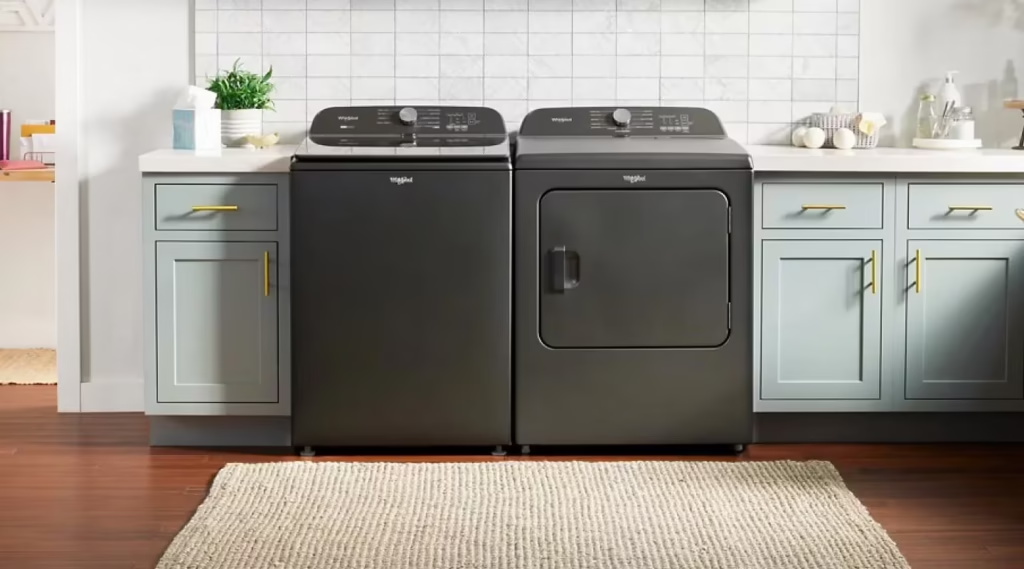
Photo Credit: whirlpool
No matter if it is a front-load or top-load type, proper maintenance and care are crucial to optimize the lifespan and performance of your washing machine. Here are some crucial washing machine maintenance recommendations for both types:
Maintenance Tips for Front-Load Washing Machines:
Clean the Door Gasket
A front-load washer’s rubber door gasket can gather lint, moisture, and debris, which can result in musty aromas and even mold or mildew development. Regularly clean the gasket using a combination of water and a light detergent, being sure to get into all the nooks and crannies. After each usage, thoroughly dry the gasket.
Cleaning the Drum
Occasionally clean the drum to get rid of any accumulation or residue that can impair the function of the washing machine. To assist get rid of any odors and keep the drum fresh, use a washing machine cleaner or run an empty cycle with hot water and vinegar.
Maintain the Detergent Dispenser
Over time, detergent residue can build up in front-load washers’ detergent dispensers. To get rid of any accumulation, remove the dispenser tray and give it a good rinse. Before putting it back in the machine, properly dry it.
Leave the Door Open
After each use, leave the door slightly ajar to allow air circulation and prevent moisture buildup. This lessens the likelihood of mold or mildew growing.
Maintenance Tips for Top-Load Washing Machines:
Clean the Drum
Top-load washers can also benefit from routine drum cleaning, just like front-loaders. To get rid of any residues or stains, clean the interior of the drum with a solution of mild detergent and water.
Clean the Agitator or Impeller
If your top-load washer has an agitator or impeller, make sure to clean it periodically. Eliminate any accumulation, lint, or debris that might impair its functionality.
Clean the Filter
Some top-load washers have a filter that traps lint and debris. For directions on how to reach and clean the filter, consult the washer’s handbook. Maintaining proper water flow and washing effectiveness requires regular cleaning.
Balance the Load
To avoid straining the motor and suspension system, avoid overloading the washing machine. To maintain balance during the wash cycle, distribute the clothing in the drum equally.
General Maintenance Tips for Both Types:
Use the Correct Detergent
Adhere to the manufacturer’s instructions on the kind and quantity of detergent to use. Using too much detergent might result in excess suds, residue buildup, and possible machine damage.
Run Monthly Maintenance Cycles
Run a maintenance cycle on a monthly basis to maintain your washing machine functioning at its best. Running an empty cycle with hot water and a washing machine cleanser or a vinegar and baking soda solution can do this.
Check Hoses and Connections
Frequently look for leaks or other damage in the hoses and connections. To avoid any potential water damage or malfunctions, replace any worn-out hoses or broken components.
Level the Machine
To avoid excessive vibration when operating, make sure that your washing machine is correctly leveled. Make any necessary adjustments to the machine’s feet using a level.
You can increase the lifespan and operational efficiency of your washing machine according to these maintenance and care guidelines. Your washer will continue to operate at its best for many years if you keep it clean often, use the right detergent, and pay attention to maintenance chores.
Conclusion
In conclusion, while deciding between front-load and top-load washing machines, it’s important to take a variety of aspects into account, including space constraints, energy efficiency, load capacity, cleaning effectiveness, and maintenance needs. Top-load washers provide convenience and ease of use, whereas front-load washers have advantages including higher load capacity and energy efficiency. Users may make a choice that best meets their unique demands by assessing these elements and taking into account their own wants. If you want your chosen washing machine to last a long time and work at its best, remember to undertake the recommended maintenance procedures.
Frequently Asked Questions
1: Which type of washing machine is more energy-efficient?
Washing machines that load from the front or the top have the potential to be energy-efficient. Front-load washers are, however, typically thought to be more energy-efficient. They often take less detergent, consume less water, and spin faster, which shortens the drying time. Over time, this energy efficiency may lead to cost savings.
2: Are front-load washers more expensive than top-load washers?
Compared to top-load washers, front-load washers often cost more up front. The more expensive pricing is a result of the improved features, greater load capabilities, and energy-efficient designs. However, it’s crucial to take into account long-term reductions in energy and water use, as front-load washers might result in cost savings over time.
C. Can I use regular laundry detergent in both types of washers?
Yes, both top-load and front-load washers accept normal laundry detergent. However, it’s important to adhere to the manufacturer’s instructions and use the amount of detergent that is suggested for each type of washer. Using too much detergent might result in too sudsy water, inadequate rinsing, and possible machine damage.
4: Do top-load washers provide better fabric care?
When used properly, top-load and front-load washers may both effectively care for fabrics. With its softer washing motion and tumbling movement, front-load washers are sometimes thought of as being kinder on fabrics. Modern top-load washers with impellers or unique drum designs, however, can also offer superior fabric care. For the best fabric care, it’s critical to adhere to the care label directions and choose the right wash cycle.
5: Can I stack a front-load washer and dryer to save space?
Yes, front-load washers and dryers are frequently made to stack, which can help you save important room in your laundry room. Before attempting to stack the units, it’s vital to examine the manufacturer’s specs and recommendations because not all models are stackable. Additionally, make sure you have a stacking kit that is appropriate so you can securely mount the dryer above the washer.
